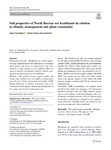Mostrar o rexistro simple do ítem
Soil properties of North Iberian wet heathlands in relation to climate, management and plant community
| dc.contributor.author | Fagúndez, Jaime | |
| dc.contributor.author | Pontevedra-Pombal, Xabier | |
| dc.date.accessioned | 2022-07-05T11:34:57Z | |
| dc.date.available | 2022-07-05T11:34:57Z | |
| dc.date.issued | 2022-04-05 | |
| dc.identifier.citation | Fagúndez J, Pontevedra-Pombal X (2022) Soil properties of North Iberian wet heathlands in relation to climate, management and plant community. Plant Soil 475:565–580. https://doi.org/10.1007/s11104-022-05393-6 | es_ES |
| dc.identifier.issn | 1573-5036 | |
| dc.identifier.issn | 0032-079X | |
| dc.identifier.uri | http://hdl.handle.net/2183/31075 | |
| dc.description | Financiado para publicación en acceso aberto: Universidade da Coruña/CISUG | es_ES |
| dc.description.abstract | [Abstract] Background and aims: Heathlands are a broad vegetation type characterized by the dominance of evergreen shrub species that thrive on nutrient-poor soils, thus sensitive to small changes in soil conditions. Here we aimed to identify soil gradients related to climate, management and main species in wet heathlands. Methods: Soil nutrient levels, organic matter and acidity were studied at two soil depths on ninety plots from 18 sites in Erica mackayana wet heaths of NW Iberian Peninsula, in relation to presence and cover of structural plant species (shrubs and graminoids) at two scales: plot and site (landscape) scale. Results: We identified one main soil gradient explained by soil organic matter (SOM), the effective cation exchange complex (eCEC), available phosphorus (P), and Aluminium-Calcium ratio (Al:Ca). Cattle density had a positive correlation with the main gradient in the surface layer, all other climate and management factors were unrelated to soil conditions. Molinia caerulea had a positive relation with SOM, eCEC, basic cations and low Al:Ca ratio. Erica cinerea showed the opposite reaction at both scales. Ulex gallii showed a negative correlation with C:N ratio at the plot scale and deeper layer. Conclusion: SOM accumulation, low nutrient levels and Al toxicity explain the uniqueness of E. mackayana heathland vegetation and soils. Main indicator species react to soil conditions at plot and landscape scales. Cattle density correlated positively with soil nutrient levels, but density of wild ponies is unrelated to soil conditions. Large herbivores, especially ponies, are needed for conservation management of these heathlands. | es_ES |
| dc.language.iso | eng | es_ES |
| dc.publisher | Springer Nature | es_ES |
| dc.relation.uri | https://doi.org/10.1007/s11104-022-05393-6 | es_ES |
| dc.rights | Atribución 3.0 España | es_ES |
| dc.rights.uri | http://creativecommons.org/licenses/by/3.0/es/ | * |
| dc.subject | Erica mackayana wet heaths | es_ES |
| dc.subject | Molinia caerulea | es_ES |
| dc.subject | Erica cinerea | es_ES |
| dc.subject | Phosphorus | es_ES |
| dc.subject | Soil nutrients | es_ES |
| dc.subject | Soil organic matter | es_ES |
| dc.subject | Soil pH | es_ES |
| dc.title | Soil properties of North Iberian wet heathlands in relation to climate, management and plant community | es_ES |
| dc.type | info:eu-repo/semantics/article | es_ES |
| dc.rights.access | info:eu-repo/semantics/openAccess | es_ES |
| UDC.journalTitle | Plant and Soil | es_ES |
| UDC.volume | 475 | es_ES |
| UDC.startPage | 565 | es_ES |
| UDC.endPage | 580 | es_ES |






